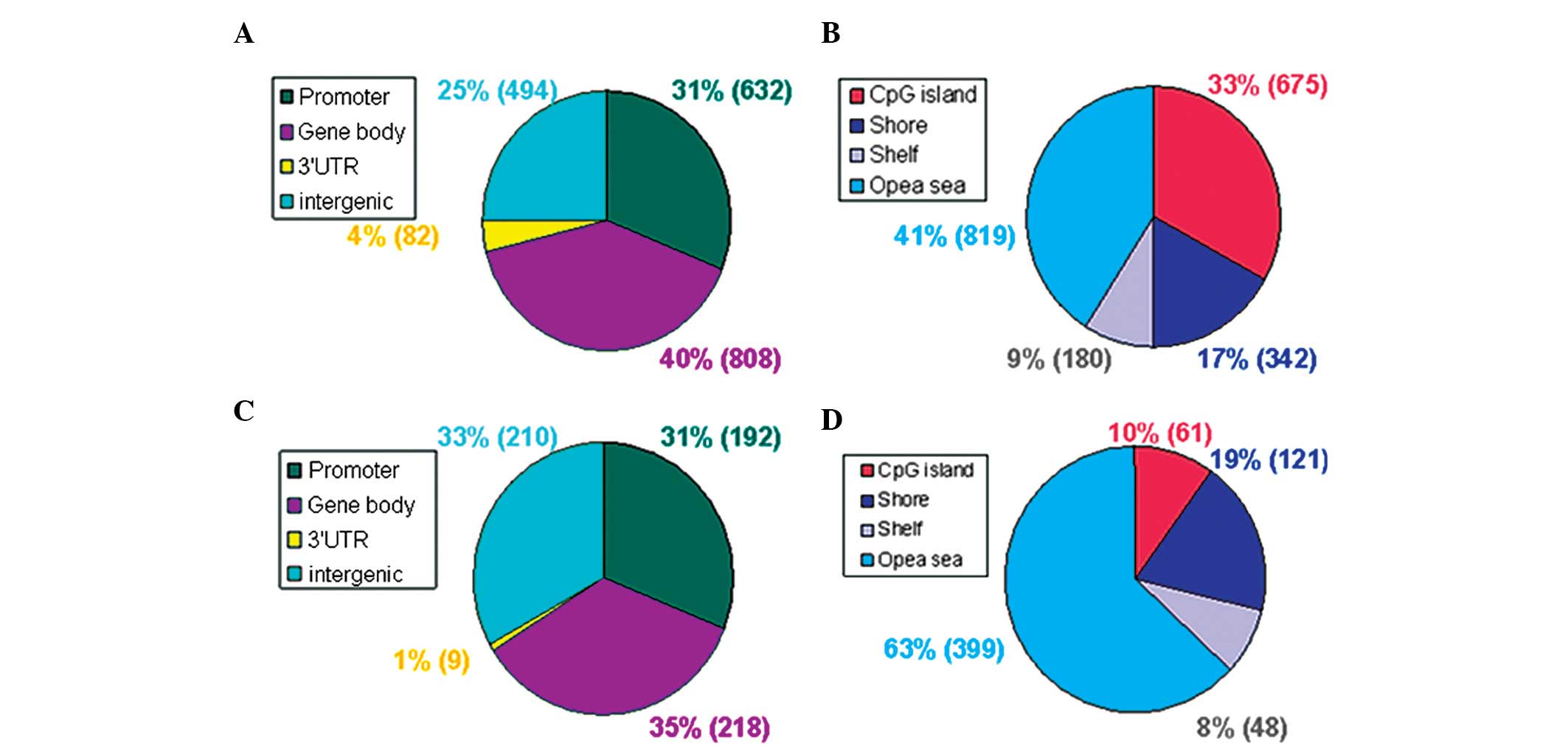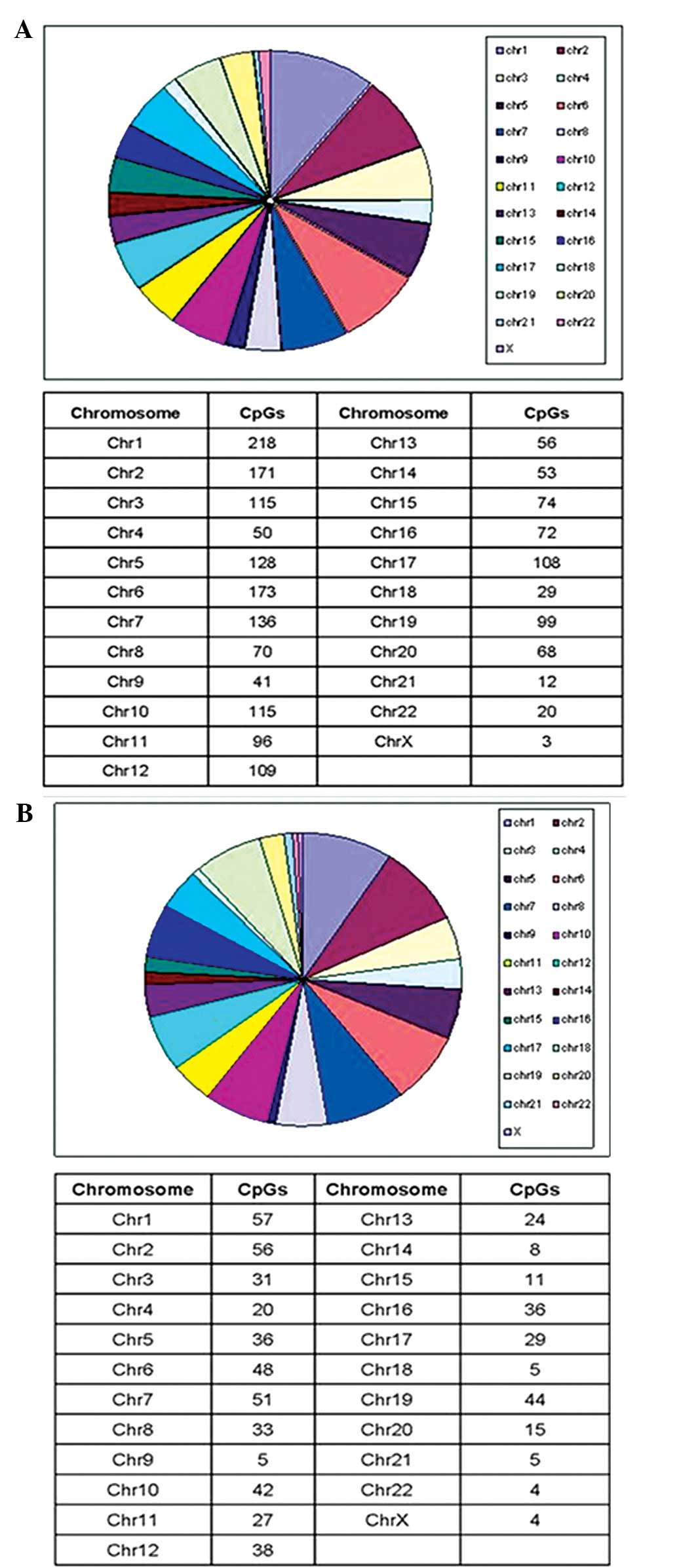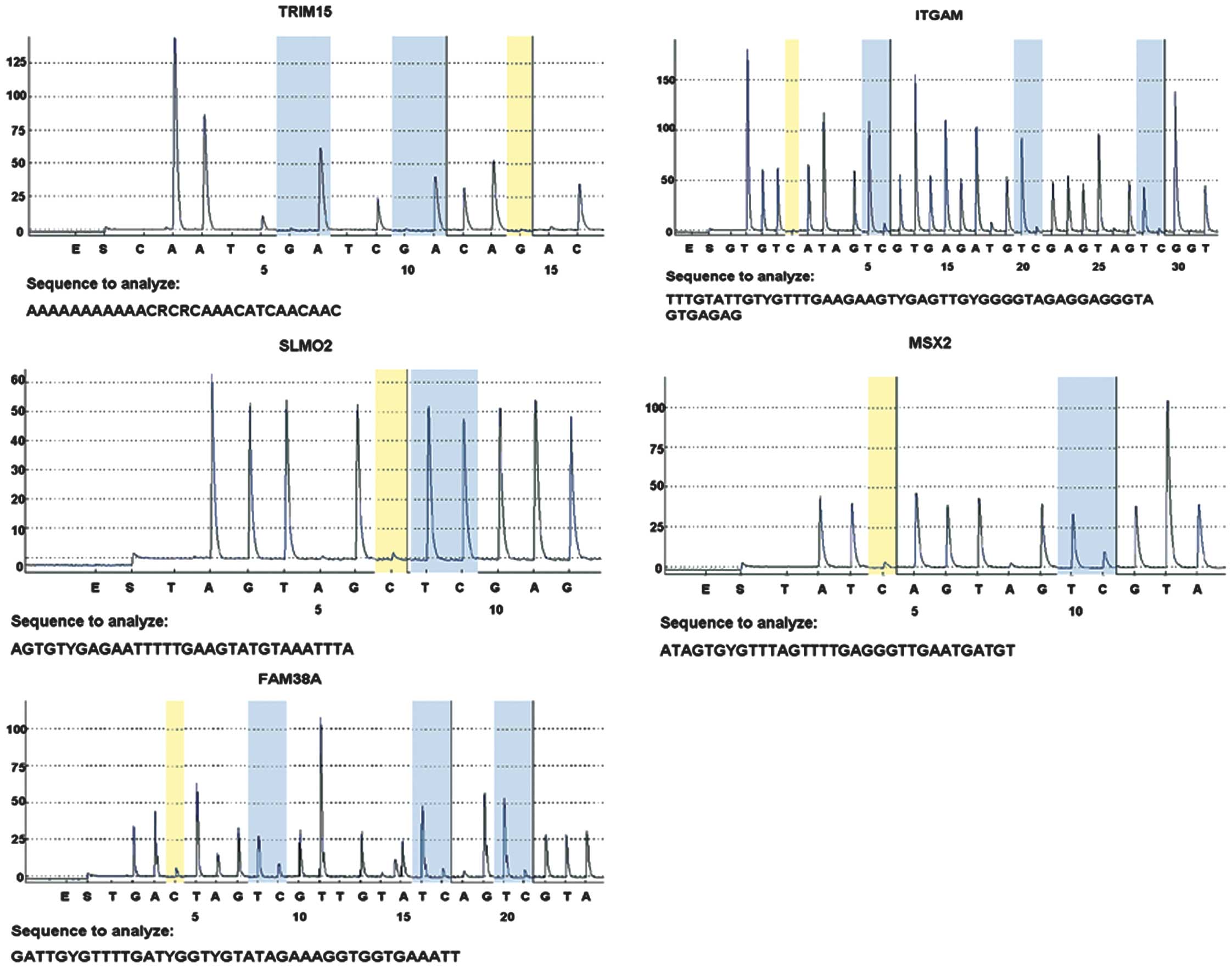Analysis of DNA methylation patterns associated with the gastric cancer genome
- Authors:
- Published online on: January 29, 2014 https://doi.org/10.3892/ol.2014.1838
- Pages: 1021-1026
Abstract
Introduction
Gastric cancer is a malignant disease with high incidence and mortality rates, particularly in Asian populations (1,2). The oncogenesis and development of gastric cancer are influenced by genetic and epigenetic factors. DNA methylation is the most studied epigenetic mechanism. At present, the focus of the majority of studies is the inactivation of gene expression by hypermethylation of DNA located in tumor suppressor gene promoter regions. The observation that promoter CG island methylation inactivates a number of tumor suppressor genes in gastric cancer, such as RASSF1A, P16 and E-cadherin, has increased the understanding of the mechanism of gastric carcinogenesis (3). For technical reasons, the majority of previous studies have focused on only a few genes. With the development of sequencing and microarray technology, a large-scale study of the pattern of DNA methylation, which is also called the methylome, became possible (4,5). The present study analyzed DNA methylation characteristics of the gastric cancer genome using the Infinium 450K methylation microarray to further understand the pathogenesis of gastric cancer and identify potential therapeutic targets and diagnostic markers for gastric cancer.
Materials and methods
Clinical samples
In total, 40 patients with gastric cancer from the Wuhan General Hospital of the Guangzhou Command (Wuhan, China) during the period between March 2011 and June 2012 were included. Each tumor sample was matched with adjacent apparently normal mucosa (3–5 cm from the tumor margin) removed during the same surgery. All samples were collected by one surgical pathology fellow from the operating room immediately following the surgical resection and frozen in the liquid nitrogen. Pathological diagnosis was determined independently by two pathologists and disagreement was resolved by consensus. The study protocol was approved by the ethics committee of Wuhan General Hospital of Guangzhou Command (Wuhan, China).
Genomic DNA extraction and quality control
DNA was extracted from ~25 mg of tissue using a DNA extraction kit (Quick-gDNA MiniPrep; Zymo Research Corporation, Orange, CA, USA) according to the manufacturer’s instructions, and DNA quality was assessed using spectrophotometry (UV-100, Shanghai Precision Instrument Co., Ltd., Shanghai, China) and agarose gel electrophoresis (Amresco LLC, Solon, OH, USA).
DNA methylation profiling with Infinium 450K methylation assay
In total, six paired samples were processed on the chip (12 samples/chip). Genomic DNA (500 ng) was treated with sodium bisulfite using the Zymo EZ DNA Methylation Kit™ (Zymo Research Corporation) according to the manufacturer’s instructions, with the alternative incubation conditions recommended for the Illumina Infinium 450K methylation assay (Illumina Inc., San Diego, CA, USA). The methylation assay was performed on 4 μl of bisulfite-converted genomic DNA at 50 ng/μl according to the Infinium HD methylation assay (Illumina Inc.) instructions. The quality of the results was assessed using the GenomeStudio™ Methylation Module v1.8 software (Illumina, Inc., San Diego, CA, USA) and all samples passed this quality control. β-values were extracted using the same software.
Bisulfite pyrosequencing
A total of six CpGs sites were selected for technical validation of Infinium 450K methylation by the bisulfate pyrosequencing technique on 40 paired samples (cancer and normal tissues). One candidate site in each of the five genes (TRIM15, ITGAM, SLMO2, MSX2 and FAM38A) was selected and all were located in the gene body. Primers for polymerase chain reaction (PCR) amplification and sequencing were deduced using the PyroMark Assay Design 2.0 software (Qiagen, Hilden, Germany) and all primer sequences are shown in Table I. Bisulfite conversion of genomic DNA was performed, followed by PCR. PCRs were performed under the following conditions: 95°C for 15 min; 45 cycles of 94°C for 30 sec, 56°C for 30 sec, 72°C for 30 sec; and 72°C for 10 min. The success of amplification was assessed by agarose gel electrophoresis and pyrosequencing of the PCR products was performed using the PyromarkID system (Qiagen). Only blue values (perfect calls) were considered for subsequent analyses.
RNA extraction and quantitative PCR (qPCR)
Total cellular RNA was extracted using the TRIzol method. RNA quality was assessed by spectrophotometry and agarose gel electrophoresis. A total of 5 μg of RNA was reverse transcribed using the All-in-One™ First Strand cDNA synthesis kit (AORT-100; GeneCopoeia™, Rockville, MD, USA). Quantitative qPCR amplification reactions were performed using the All-in-One qPCR master mix (AOPR-1200; GeneCopoeia) with a Real-Time PCR system (ABI StepOne plus; Applied Biosystems, Carlsbad, CA, USA). The expression levels of the genes were normalized to the expression of actin. Primer sequences and PCR conditions are shown in Table II.
Bioinformatics analysis
Integrated gene ontology and pathway analysis database MAS3.0 (http://www.capitalbio.com) were to investigate potential molecular function and the pathway of the candidate biomarkers.
Statistical analysis
All statistical analyses were performed using SPSS 13.0 for Windows (SPSS, Inc., Chicago, IL, USA). Group comparisons were performed using a paired samples t-test. Two-sided P<0.05 was considered to indicate a statistically significant difference.
Results
Patients
The present study was conducted on 40 patients (23 male and 17 female) with gastric cancer, with a mean age of 56 years. The methylation microarray procedure was performed on specimens from six patients. The tumors were all adenocarcinomas.
Pyrosequencing
Pyrosequencing was performed on specimens from 40 patients. In total, 2,645 methylation differential sites (covering 1,352 genes) were detected in the gastric cancer tissues compared with the normal tissues. In the gastric cancer tissue, 2,016 sites (covering 1,008 genes) were hypermethylated and 629 sites (covering 344 genes) were hypomethylated (Table III). From the functional genome distribution standpoint, 824 sites (31%) were located in promoters and 1,026 sites (39%) are located in the gene body. In addition, 91 sites (3%) and 704 sites (27%) corresponded to the 3′-untranslated regions and intergenic sequences, respectively. From the CpG content and neighborhood context, 736 CpG sites (28%) were in CpG islands, 463 (17%) were in CpG shores, 228 (9%) were in CpG shelves and 1,218 (46%) were in the ‘open sea’ (isolated CpGs in the genome). The methylation differential sites were distributed among all 22 autosomal chromosomes and one sex chromosome. The majority of positions were harbored in chromosome one (9.1%), followed by chromosomes two (8.9%) and six (7.7%). The distribution of these sites is shown in Figs. 1 and 2.
Gene regulation
A total of 979 genes were upregulated and 314 genes were downregulated in gastric cancer samples compared with the normal samples. Signaling pathway analyses showed that the majority of the genes that were upregulated and downregulated in gastric cancer were involved in the same pathways, including apoptosis, cell cycle, ErbB, Janus kinase-signal transducer and activator of transcription, mitogen-activated protein kinases, p53, transforming growth factor-β, Toll-like receptor, vascular endothelial growth factor and Wnt signaling pathways. We proposed that these pathway alterations may be associated with the clinical pathological features and outcome of GC patients. An integrated gene ontology database was used to annotate the molecular function of the differentially expressed genes. The results showed that genes that were upregulated and downregulated in gastric cancer were involved in the majority of the important biological process associated with human cancer, including regulation of the inhibitor-κB kinase/nuclear factor-κB cascade, cell differentiation, cell cycle arrest, caspase activation and cell proliferation (Table IV).
Methylation levels
In total, five differential sites (TRIM15, ITGAM, SLMO2, MSX2 and FAM38A) were selected and verified in 40 samples by pyrosequencing. The mean methylation levels of gastric cancer tissues were higher than those of normal gastric tissues for two sites (TRIM15 and ITGAM) and lower for two sites (MSX2 and FAM38A), which were consistent with the results of the microarray analysis. The mean methylation level of SLMO2 was not different between normal and cancer tissues (Table V, Fig. 3).
Transcriptional levels
To examine the transcriptional level of the four genes (TRIM15, IGTAM, MSX2 and FAM38A), qPCR was performed using primers specific for these genes. qPCR results showed that the expression levels of ITGAM, MSX2 and FAM38A were upregulated in gastric cancer tissues, while the expression level of TRIM15 was downregulated (P<0.05).
Discussion
DNA methylation is important in the development of gastric cancer. Previously, it has been found that hypermethylation inactivates a number of gene promoters. However, previous studies have been limited by technology that only allows analysis of a few genes. In addition, the majority of studies have paid close attention to the CpG island in the promoter region. According to current knowledge, only a few CpG dinucleotides have been identified at the promoter CpG islands, mostly scattered in the genome. In tumorigenesis, the importance of scattered CpG dinucleotide methylation remains poorly understood (6,7). Therefore, understanding genome-wide DNA methylation changes is necessary for the in-depth investigation of tumor occurrence.
The latest generation of methylation microarrays includes the Infinium 450K methylation microarray. This microarray detects >450,000 methylation sites per sample. It includes methylation regions, such as CpG islands, CpG shores, CpG sites outside of CpG islands, non-CpG methylated sites identified in human stem cells, differentially methylated sites identified in tumor versus normal tissues (multiple forms of cancer), across several tissue types, CpG islands outside of coding regions, miRNA promoter regions and disease-associated regions identified through genome-wide association study (8). To date, the Infinium 450K methylation microarray is the most attractive, powerful and cost-effective tool available for generating quantitative DNA methylomes in healthy and diseased individuals (9,10). Using the Infinium 450K methylation microarray, the present study compared the genomic DNA methylation of gastric cancer with that of normal gastric tissue, screened 2,645 differential sites, showed the detailed distribution of these differential sites and established a gastric cancer DNA methylation profile. Verification of the microarray results by pyrosequencing showed that these results were reliable.
A considerable number of differentially methylated sites are located in the promoter region. However, the majority of them appear within the gene body. A number of previous studies have shown abnormal methylation of the CpG island in the promoter region and increasing attention has been paid to methylation of the gene body (11,12). Unlike the correlation between promoter DNA methylation and gene transcription inhibition, the correlation between gene body methylation and gene expression is more complicated. A meta-analysis of this correlation by Jjingo et al (13) suggested that the gene body DNA methylation is highest when gene expression is moderate. Additionally, when gene expression is high or low, the degree of gene body DNA methylation is extremely low. In the current study of the correlation between methylation changes in four selected differentially methylated sites in the genome and gene expression, the effects of DNA methylation on gene expression varied between genes.
The current study found that the methylation changes in certain genes occurred in multiple sites, some in the promoter and some in the gene itself; certain sites became hypermethylated and others hypomethylated, which suggested that gene expression is regulated by complicated patterns of multi-site methylation. Bioinformatics analysis suggested no difference between genes with hypermethylated sites and genes with hypomethylated sites in associated signaling pathways, which included signaling pathways involved in apoptosis, cell proliferation and cell cycle control.
The present relatively large-scale investigation of methylation changes of gastric cancer, covering a relatively large genomic area, found a number of new differentially methylated sites, including hypermethylation and hypomethylation sites. Analysis of the results identified TRIM15, ITGAM, MSX2 and FAM38A as possible candidate sites clinically useful for the diagnosis and treatment of gastric cancer. In addition, a number of differentially methylated sites were identified in the microRNA gene. Further studies must be performed to explain this phenomenon.
References
|
Leung WK, Wu MS, Kakugawa Y, et al; Asia Pacific Working Group on Gastric Cancer. Screening for gastric cancer in Asia: current evidence and practice. Lancet Oncol. 9:279–287. 2008. View Article : Google Scholar : PubMed/NCBI | |
|
Brenner H, Rothenbacher D and Arndt V: Epidemiology of stomach cancer. Methods Mol Biol. 472:467–477. 2009. View Article : Google Scholar | |
|
Sapari NS, Loh M, Vaithilingam A and Soong R: Clinical potential of DNA methylation in gastric cancer: a meta-analysis. PLoS One. 7:e362752012. View Article : Google Scholar : PubMed/NCBI | |
|
Laird PW: Principles and challenges of genomewide DNA methylation analysis. Nat Rev Genet. 11:191–203. 2010. View Article : Google Scholar : PubMed/NCBI | |
|
Ku CS, Naidoo N, Wu M and Soong R: Studying the epigenome using next generation sequencing. J Med Genet. 48:721–730. 2011. View Article : Google Scholar : PubMed/NCBI | |
|
Shenker N and Flanagan JM: Intragenic DNA methylation: implication of this epigenetic mechanism for cancer research. Br J Cancer. 106:248–253. 2012. View Article : Google Scholar | |
|
Lister R, Pelizzola M, Dowen RH, et al: Human DNA methylomes at base resolution show widespread epigenomic differences. Nature. 462:315–322. 2009. View Article : Google Scholar : PubMed/NCBI | |
|
Sandoval J, Heyn HA, Moran S, et al: Validation of a DNA methylation microarray for 450,000 CpG sites in the human genome. Epigenomics. 6:692–702. 2011.PubMed/NCBI | |
|
Dedeurwaerder S, Defrance M, Calonne E, et al: Evaluation of the Infinium Methylation 450K technology. Epigenetics. 3:771–784. 2011.PubMed/NCBI | |
|
Rakyan VK, Down TA, Balding DJ and Beck S: Epigenome-wide association studies for common human diseases. Nat Rev Genet. 12:529–541. 2011. View Article : Google Scholar : PubMed/NCBI | |
|
Maunakea AK, Nagarajan RP, Bilenky M, et al: Conserved role of intragenic DNA methylation in regulating alternative promoters. Nature. 466:253–257. 2010. View Article : Google Scholar | |
|
Ball MP, Li JB, Gao Y, et al: Targeted and genome-scale strategies reveal gene-body methylation signatures in human cells. Nat Biotechnol. 27:361–368. 2009. View Article : Google Scholar : PubMed/NCBI | |
|
Jjingo D, Conley AB, Yi S, et al: On the presence and role of human gene-body DNA methylation. Oncotarget. 3:462–474. 2012.PubMed/NCBI |












